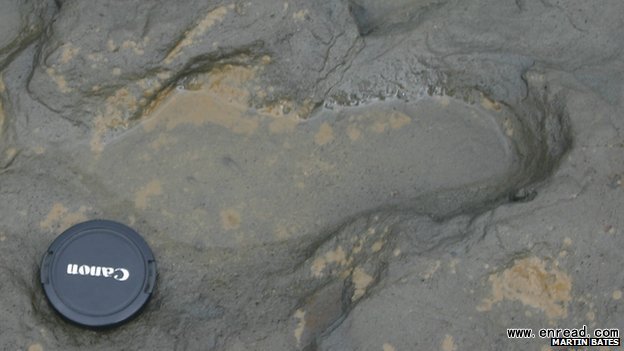| ||||||||||||||||||||||||||||||||
|
scientists have discovered the earliest evidence of human footprints outside of africa, on the norfolk coast in the east of england.
科学家在英格兰东部黑斯堡海岸上发现80多万年前的人类脚印遗迹,这是非洲之外最古老的人类脚印遗迹,直接证明欧洲北部早期人类的存在。
 the footprints on happisburgh beach are possibly those of a family in search of food the footprints are more than 800,000 years old and were found on the shores of happisburgh.
they are direct evidence of the earliest known humans in northern europe.
details of the extraordinary markings have been published in the science journal plos one.
the footprints have been described as "one of the most important discoveries, if not the most important discovery that has been made on [britain's] shores," by dr nick ashton of the british museum.
"it will rewrite our understanding of the early human occupation of britain and indeed of europe," he told bbc news.
the markings were first indentified in may last year during a low tide. rough seas had 1 the sandy beach to reveal a series of 2(瘦长的) hollows.
i walked with dr ashton along the shore where the discovery was made. he recalled how he and a colleague stumbled across the hollows: "at the time, i wondered 'could these really be the case? if it was the case, these could be the earliest footprints outside africa and that would be absolutely incredible."
such discoveries are very rare. the happisburgh footprints are the only ones of this age in europe and there are only three other sets that are older, all of which are in africa.
"at first, we weren't sure what we were seeing," dr ashton told me, "but it was soon clear that the hollows resembled human footprints."
the hollows were washed away not long after they were identified. the team were, however, able to capture the footprints on video that will be shown at an exhibition at london's natural history museum later this month.
the video shows the researchers on their hands and knees in cold, driving rain, engaged in a race against time to record the hollows. dr ashton recalls how they 3 out rainwater from the footprints so that they could be photographed. "but the rain was filling the hollows as quickly as we could empty them," he told me.
the team took a 3d scan of the footprints over the following two weeks. a 4 analysis of these images by dr isabelle de groote of liverpool john moores university confirmed that the hollows were indeed human footprints, possibly of five people, one adult male and some children.
dr de groote said she could make out the heel, arch and even toes in some of the prints, the largest of which would have filled a uk shoe size 8 (european size 42; american size 9) .
"when i was told about the footprints, i was absolutely stunned," dr de groote told bbc news.
"they appear to have been made by one adult male who was about 5ft 9in (175cm) tall and the shortest was about 3ft. the other larger footprints could come from young adult males or have been left by females. the glimpse of the past that we are seeing is that we have a family group moving together across the landscape."
点击  收听单词发音 收听单词发音
|
||||||||||||||||||||||||||||||||
上一篇: 下一篇: |
||||||||||||||||||||||||||||||||
- 发表评论
-
- 最新评论

